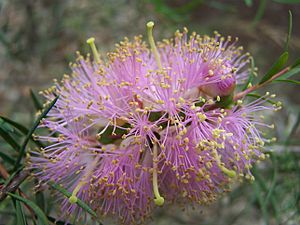Graceful honey-myrtle facts for kids
Quick facts for kids Graceful honey-myrtle |
|
|---|---|
 |
|
| M. radula (cultivated) in Kings Park, Perth | |
| Scientific classification | |
| Genus: |
Melaleuca
|
| Species: |
radula
|
The Melaleuca radula, also known as the graceful honey-myrtle, is a beautiful plant that belongs to the myrtle family. It grows naturally only in the south-west part of Western Australia. This plant is a spreading shrub with thin leaves and lots of pink or purple flowers that bloom in late winter. After the flowers, it grows smooth, round fruits.
Contents
What Does It Look Like?
The graceful honey-myrtle is a shrub that can grow up to 5 m (20 ft) tall. It has rough bark on its trunk and branches. Its leaves are arranged in a special way: they grow in opposite pairs, turning slightly so they form four neat rows along the branches.
The leaves are usually 10–45 mm (0.4–2 in) long and 0.7–2 mm (0.03–0.08 in) wide. They are long and narrow, sometimes shaped like a crescent moon when you look at them from the side. You can also see tiny oil glands on the underside of the leaves.
The flowers are often pink or purple, but sometimes they can be white. They grow in pairs, forming a fluffy spike that can be up to 40 mm (2 in) long and 30 mm (1 in) wide. Each flower has petals that are about 4.5–6.5 mm (0.2–0.3 in) long, which fall off as the flower gets older. There are five groups of stamens (the parts that make pollen) around each flower, with 30 to 90 stamens in each group. This is what makes the flower spikes look so fluffy!
Most of the flowers appear from July to September. After the flowers fade, the plant produces woody, almost round fruits called capsules. These fruits are about 4–6 mm (0.16–0.24 in) wide and grow in clusters along the stem.
How It Got Its Name
The graceful honey-myrtle was first officially described in 1839 by a person named John Lindley. He wrote about it in a book called A Sketch of the Vegetation of the Swan River Colony.
The plant's scientific name, radula, comes from a Latin word that means "a scraper." It's not completely clear why Lindley chose this name for the plant.
Where It Grows
This type of melaleuca plant is found in Western Australia. It grows in areas between Kalbarri, Perth, and Norseman.
You can find it in different natural areas like the Avon Wheatbelt, Coolgardie, and Swan Coastal Plain. It likes sandy and gravelly soils, often growing near granite or laterite rocks, and close to creeks and streams.
Conservation Status
The Melaleuca radula is currently listed as "not threatened" by the Government of Western Australia Department of Parks and Wildlife. This means it is not considered to be in danger of disappearing.
Traditional Uses
The Noongar Aboriginal people, who are the traditional owners of the land where this plant grows, have used the graceful honey-myrtle for a long time.
They would boil the leaves in water to make a special liquid. This liquid was used as an antiseptic mouthwash to help with sore gums. They also put it on sores and other skin problems. If someone had an upset stomach or indigestion, they would drink this liquid. Young leaves were also chewed to help with headaches.
Scientists believe that a natural compound called terpinen-4-ol found in the plant's oil is what gives it its antibacterial and antiseptic qualities.
Images for kids
-
M. radula growing on Mt. O'Brien near Wongan Hills



